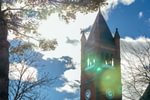

When Prof. Carolyn Snively began digging near Konjuh, a remote village in northern Macedonia, a lot of archaeologists thought she was wasting her time. “Most people didn’t think we could find anything of interest out here,” she said. She found plenty. Since 2000, Snively, a professor in the Department of Classics, has returned each summer to this remote corner of the Balkans to excavate a city that flourished here in the fifth and sixth centuries. She and a small collection of archaeologists, Gettysburg students, and local workers have studied features, including whole rooms, which the inhabitants cut into the rock. They’ve uncovered the stone walls of residences; excavated the foundation of a Christian basilica with characteristics found nowhere else in the Balkans; unearthed streets, passages, and doorways; and discovered many artifacts.

No one knows the city’s name. Local people call it simply “Golemo Gradište,” or “big hilltop settlement.” From the evidence she’s found, Snively concludes that Golemo Gradište was a heavily fortified city in the final turbulent centuries of the Roman Empire, when power was shifting from Rome to Constantinople, Christianity was spreading and displacing the old Roman gods, and invasion was an increasing occurrence. Whoever founded the city chose a spot with strategic and economic value. Golemo Gradište lay in a rich mining region; it overlooked a major east-west road that connected larger cities—Scupi, at modern-day Skopje, and Serdica, at Sofia, in Bulgaria. It enjoyed strong natural defenses, including the Kriva River. It was big enough to have a large church, and probably a bishop.
Why was it built? What did people do there? Why was it abandoned in the seventh century, barely two centuries after its founding? The historical record is scant. And yet Snively’s work at Golemo Gradište has enlarged archaeologists’ understanding of the kinds of settlements in which people lived during Late Antiquity. It has also begun to shed light on the social and economic life of a provincial Balkan city in the late years of the Roman Empire.
Snively works by a kind of triangulation, measuring what she’s discovered through excavation against the findings of other archaeologists and what she describes as a “spotty” historical record. She prefers an archaeology of ideas over an archaeology of objects—the hunt for beautiful artifacts that might grace a museum case. Few such objects have been found at Golemo Gradište.
She began working in the Balkans in the early 1970s, when she was a graduate student at the University of Texas. At Stobi, a Hellenistic, Roman, and Late Antique city in central Macedonia, she developed an interest in urbanism—the study of the character and organization of city life—and in the architecture of early Christian churches.
By the 1990s she was teaching at Gettysburg and looking for a site where she could lead her own excavations. It wasn’t easy. The Balkans abound in ancient ruins, but the 1980s and 1990s were decades of turmoil, as Yugoslavia tottered and wars broke out in Croatia, Bosnia, and Kosovo. In 1990, she accompanied local archaeologists to Golemo Gradište, bouncing down dirt roads in a cramped Zastava. It was the first of two trips. “We looked it over and said, ‘Hey, this has possibilities,’” she said.
To get permission to dig, Snively needed a Macedonian collaborator. In 1998, she participated in a pilot project that involved surveying the ruins of a small church, dubbed the “Rotunda,” which had stood outside the city walls at Golemo Gradište. Two years later, she began excavations at Golemo Gradište, teaming up with archaeologists at the Museum of Macedonia in a joint Gettysburg-Macedonia project.
They’ve been at it ever since. The excavation team varies year to year but typically consists of a handful of archaeologists and two or three dozen laborers hired locally. Funding has come from different sources, including the Macedonian government, the Dumbarton Oaks Foundation, the Loeb Classical Library Foundation, and Gettysburg College. An excavation season lasts five or six weeks before the money runs out and everyone is exhausted.
Golemo Gradište’s most prominent feature is its acropolis, which occupies a narrow ridge that rises 300 feet above the surrounding countryside. The sides are steep and in places fall off in rocky cliffs. That’s where Snively and her coworkers started. Some things were visible: a room cut into a cliff, a cistern filled with rubble, and a narrow terrace that the inhabitants had built. Excavation uncovered more, including streets, buildings that had been either houses or workshops, and big clay storage jars. Taken together, the evidence suggested that the acropolis had served as a fortress big enough to house soldiers, but also a place where people had lived and worked.
Snively and her team later turned their attention to a broad terrace between the ridge and the Kriva River, where the bulk of the city stood. In 2008, they ran into a curved wall. The wall belonged to the apse of a Christian basilica, the semi-circular east end where the clergy were seated. More digging revealed the main body of the church—a nave with columns, three aisles and an ambo—a raised stone platform used in the early church for reading the Gospels and Epistles. They also uncovered features unknown in the Balkans, including a semicircular stone structure on one side of the nave that they couldn’t figure out at all.
Telling the history of Golemo Gradište is like assembling a puzzle for which most of the pieces are missing. Snively believes the city began on the terrace next to the river in the middle or second half of the fifth century. Unlike most settlements of the period, the city was not built on the site of an existing Roman town. It seems to have been entirely new. One explanation for this is that invasions may have cut off Roman access to mining areas further north, increasing the importance of mines around Golemo Gradište. Another possibility is that a nearby Roman city was relocated, as many were during this period, to a site more easily defended. (None has yet been found in the area.) Snively also has concluded that the acropolis was occupied at a later date than the terrace below, probably not until the sixth century. This suggests that, at some point after the city’s founding, life at Golemo Gradište grew more precarious, prompting the inhabitants to withdraw into the acropolis. Why? Was it fear of barbarian invasion? Or of rebellious miners?
“Miners seem to have been an unruly bunch,” Snively said. “It’s one of those things I have to look into more closely. In Roman times, most miners were slaves. By Late Antiquity, they seem to have been free, or at least semi-free. But there is evidence that at least some of them were bound to mines and couldn’t leave.”
Snively is especially drawn to the architectural anomalies found in the churches at Golemo Gradište. What is the meaning, for example, of the semicircular structure in the basilica? Where did this idea come from? An expert in the architecture of early churches in Syria has suggested that the feature is Syrian. But who brought it to Golemo Gradište?
Judging from the abundance of weaponry at the site, Snively infers that life at Golemo Gradište was “nasty, brutish, and short.” She found more dead-end streets and fewer doorways than she expected. “Was this because they were concerned about security?” she said. “We don’t know.” The presence of slag, a by-product of smelting, and the abundance of iron artifacts suggest the importance of local mining. But it’s unclear where exactly the mines were then, where the ore was refined, or where the miners lived. “We don’t have much evidence of people living outside the city,” she said. Parts of looms found at Golemo Gradište suggest a textile industry, but she doesn’t know if it supplied domestic use or trade.
Archaeology is a minefield of uncertainty, and Snively treads carefully. Her observations about the site are hedged about with qualifiers. But not everything about Golemo Gradište is mysterious. Excavation has revealed the bones of familiar domestic animals, as well as scythes and other recognizable farming implements. Like their ancient precursors, rural Macedonians grow wheat and raise chickens, pigs, goats, and other livestock. They live in stone houses with orange tile roofs, which have changed little in 1,500 years. How ancient life resembled or differed from modern life is a recurring theme in Snively’s courses as she tries to bring the challenge of archaeological interpretation to the classroom.
The difficulties are not all about interpretation. The excavations at Golemo Gradište have also posed considerable logistical challenges—securing funding, getting permission to dig, hiring workers, and more. For help, Snively has leaned heavily on colleagues at the Museum of Macedonia, now the Archaeological Museum of Macedonia, and on the people of Konjuh, a poor farming village less than a mile from the site. Most of the workers at Golemo Gradište have come from Konjuh.
“There are few other opportunities,” explained Aneta Kiprijanovska, a 37-year-old woman whose husband helps organize the villagers. Villagers are glad for the extra income, but they also are proud of their contribution to archaeology. “I’m excited at the possibility of finding something,” said 15-year-old Darko Tasevski. Last year, his crew found bells and a set of earrings.

Working at the Golemo Gradište also has offered Gettysburg students a chance to learn about archaeology firsthand. For Katherine Haas ’10, the experience was transformative. She came to Golemo Gradište as a sophomore, fresh from Snively’s course in Roman civilization. She spent the season drafting maps of the site, taking measurements by day, and revising the maps at night. She came back the next year and received a promotion: her own trench to supervise. Today she is a PhD student in anthropology at the University of Pittsburgh, specializing in archaeology and forensic anthropology. She spends her summers studying 4,000-year-old skeletons in Serbia.
“The thing is with archaeology, you have this massive site, but you can only look at a very small section of it at a time,” she said. “You really have to use your imagination and picture what it was like when people lived there. That’s what kept bringing me back.”
I accompanied Snively to Golemo Gradište last August, after the excavation season had ended. She was wrapping up some business before returning to the United States, including the printing of that season’s official excavation T-shirt. We drove north early in the morning from Skopje, Macedonia’s capital, following the Alexander the Great Motorway toward the Serbian border. The summer had been hot, and the hills were brown. At the city of Kumanovo, we turned east, then left the highway and followed a narrow, winding back road through a series of villages into the Kriva River Valley. We passed small fields ripe with corn, vegetables, and hay, and women on foot carrying shopping bags and pushing bicycles. Driving past a small store, Snively announced it was the last one before the site. Seven miles farther on, she crossed the river, turned onto a dirt track, and parked under a tree.
A hundred yards away stood the Rotunda, the ruins of a small church that once stood outside the city walls. Villagers discovered the site in 1919, they say, after a local man had a dream that the site was sacred. Little remains of the old church except low limestone walls and piers that once supported columns.
“It was planned out very carefully,” Snively said as she looked around. “It was not done by local craftsmen. It was planned with great precision. It suggests that somebody came in with money—a bishop, maybe—and said, ‘I’m going to build it my way.’ He had the clout and the money to impose his idea. It lets us know that this may have been a fairly grim mining town, but there were some people here who were sophisticated and educated, and interested in religious culture and the proper way to worship—and not just worried about defending the city against uprisings of miners or barbarians.”
We hike on up toward the acropolis, crossing the low berm that marked the line of the ancient city wall, now buried, then angling up the steep slope. From the top of the ridge, we could look down and see the outlines of the basilica and neighboring buildings. The stones gleamed in the sun. “There’s a lot left to do,” Snively said.
Before climbing back down, she made her way to the west end of the ridge, descending a line of stone steps and passing rooms that had been chiseled out of the rock. She walked out on a narrow outcrop until she could go no farther and stood for several minutes looking out over the countryside. It was an old land. In mid-August, it looked parched, rugged, and inhospitable, but, in fact, it was overlaid by layers and layers of human history, going as far back as the Neolithic. It had been settled and resettled over centuries and millennia. Golemo Gradište was only one chapter in a very long story.
From the ridge, she could point to a low plateau where tombstones of Roman soldiers were found in 1995. To the east, only a mile or two away stood Cocev Kamen, or “Tsotsev’s Rock,” an outcropping famous in Macedonia for its cave, which archaeologists believe was inhabited as far back as Neolithic times. Snively was more interested in a large rock that perched unnaturally on a slope above it. “It’s as big as a house,” she said. “The question is, ‘How did it get there?’”

We followed a trail to where a fence enclosed the excavations on the terrace. When she first came to Golemo Gradište, parts of the terrace had been dug up by people looking for artifacts or maybe just stone for building. “We’ll never know what’s been taken,” she said. She walked among the buildings, lingering in the basilica, balancing on the low walls that traced the outline of a large residence. They had been excavating the residence for several years and still had not found its perimeter. Was it the house of an important family and its slaves? The local bishop? “We don’t know,” she said.
Before driving back to Skopje, Snively followed a narrow road up over the hill to Konjuh. Over the years, she has gotten to know the villagers well, including their struggles to prosper at a time when most of rural Macedonia is emptying. She’s liked and respected in Konjuh. Last summer, she acquired an abandoned house there and began fixing it up, repairing the roof, drilling a well, and hooking up a new electrical line. “I figure that, when I retire, I’ll want to spend time in the village,” she said.
Snively’s work at Golemo Gradište has been a long labor of organization and excavation, but also of study and imagination, an effort to wring as much meaning as possible from the scant evidence that remains from Late Antiquity. It’s been “endlessly fascinating,” she said. But she worried if others would find it so.
“I don’t know whether, when I retire, anyone will continue working here,” she said. “Or whether it will take another generation before someone is interested.”
In the meantime, she was getting ready for another season.
—Richard Mertens
For further reading: Texts by Prof. Snively are available on The Cupola: Scholarship at Gettysburg College, the online, open access repository maintained by Musselman Library.


